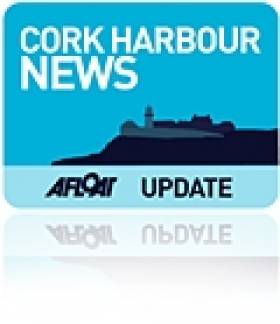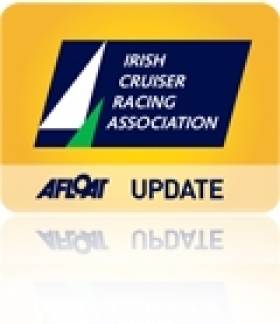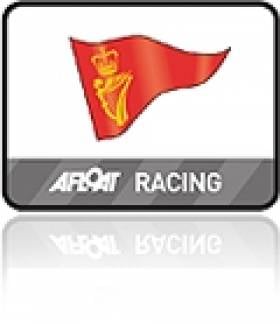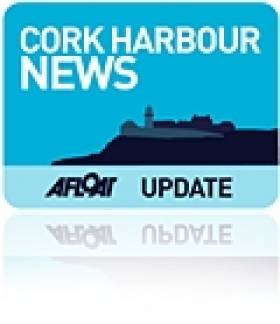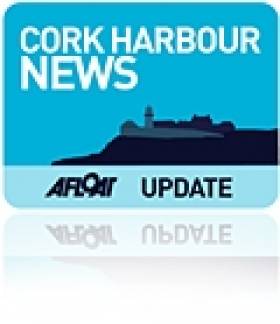Displaying items by tag: Cork
Irish Champion Tiger Heading for Cowes Quarter Ton Cup
Recently crowned ICRA IRC Three Champion, Tiger (George Kenefick) is travelling to Cowes for next week's 2011 Coutts Quarter Ton Cup hosted by the Royal Corinthian Yacht Club in Cowes, and with only a week to go, anticipation is building amongst the international fleet signed up to compete.
The black hulled champion won its class at the ICRA Nationals in Crosshaven and was second in IRC a week later at the Sovereign's Cup in Kinsale. Tiger was also second in Kinsale's newly established Quarter Ton Cup. The boat is Ireland's sole entry in the event.

Cork's Tiger is heading for Cowes and next week's Quarter Ton Cup. Photo: Bob Bateman
This is the seventh running of the event since the spectacular revival of the Quarter Ton Class back in 2005, and in addition to the core of regular domestic Quarter Ton Class aficionados who flock to Cowes each year, this year entries have also been received from France and the Netherlands, as well as from as far afield as Russia and New Zealand.
Following an afternoon of registration on Sunday 10th July and the Coutts Welcome Reception at Royal Corinthian Yacht Club that evening, racing will get underway on Monday 11th July and run through until Wednesday 13th July, with three races scheduled to take place each day. Racing will be run under the IRC handicapping system, enabling boats designed to all three versions of the Quarter Ton Class rule to compete as a single fleet.
Cork Harbour 'Mid-Summer Madness' Attracts 40 Boats
Adrielle was on station in her refurbished state with the crew still putting finishing touches to the portholes and mighty fine she looked too. Martin Almond and the Race Team sent the cruisers on course 93, two rounds for Class One and one for the other classes plus a course for the Whitesail fleet that included a beat out to number 6. As that fleet came around number 6 they were met by the other fleets coming in the harbour and it was nearly as busy as Piccadilly Circus. Nobody minded as they had a lovely 6 to 8 kts southerly breeze to make for very enjoyable sailing and made the most of the evening.
Aprés sailing there was a rush to get back to the club, for once not to have to get in out of the weather but this time the rush was to grab a seat and enjoy their barbeque food in the outside Patio dining area. I hasten to add the club was also jammed to the hilt as the sailors awaited the call to announce results and prize giving. While waiting the sound of great live music floated over Crosshaven and it was just one tremendous summer evening of sailing and fun.
At last the moment arrived and Vice Admiral Peter Deasy sounded the call to arms and Rear Admiral Ronan Enright warned anyone not present outside for the prize giving would not be considered for the draw for the Marine Motors engine which prompted a dash to the patio area. After the Leagues prize giving three tickets were drawn. Tim O'Mahony from the O'Shea/Durcan T Bone, Michael Wallace of Felix and Derry Nash of Catalpa were the tree names. Two of the three would get bottles of champagne with the last remaining name getting the engine. Derry Nash turned out to be the lucky punter and was thrilled with his luck on the night.
Next Thursday night a new sponsor, the very well known Timberland, will be on board for the July league. Racing will take place on July 7th, 14th, 21st and 28th. The company is offering a 20% discount on their products for RCYC members on production of their membership cards.
Minister for the Marine Simon Coveney, in his address to the participants, emphasised the importance of the maritime sector and his determination to oversee a major growth in added value for the fishing industry.
The very successful Summer School on Friday 10th June on the theme 'Recreation in a Working Port' saw 8 speakers address an audience of 60+ representatives from a wide range of interests on topics ranging from the history and heritage of the harbour, its potential for recreation and its presence in art an imagination . Key speakers included Louis Duffy of Cork County Council, who presented the Council's hot off the press Cork Harbour Study, Arend Lambrechtsen from the Netherlands, Jim Murphy of the Passage West & Monkstown Harbour Users' Group, Clare Wright of CAAN, who outlined the exemplary programme for development of canoe trails in Northern Ireland, Josephine O'Driscoll of Failte Ireland and Ryan Howard of SECAD, the Leader group which covers the harbour area. Session chairmen were Cathal O'Mahony of UCC's Coastal and Marine Research Centre (CMRC), who set Cork Harbour in its place in the world, Cork City Council's Damien O'Mahony and Tom MacSweeney who led the question and answer session. The event concluded with Seamus Harrington reading his poem Blind Harbour.
Pádraig Ó Duinnín outlined the journey undertaken by Meitheal Mara in arriving at the promotion of their first Summer School. The event was organised by Marina Sheehan of Meitheal Mara in the splendid boardroom of the Port of Cork overlooking their new city-centre marina.
ICRA Racing Underway in Crosshaven
Tingle's 'Alpaca' Wins Class Two of Union Chandlery League
There were concentrated faces last night in Cork Harbour where the Royal Cork fleet had a windy evening of racing in the Union Chandlery June League.
Brian Heffernan's Dufour 365 Aisling was first in the in White Sail division. Class 3 went to Jimmy Nyhan and Maritta Buwalda in their Quarter Tonner Outrigger. Class 2 winners were Paul and Deirdre Tingle's First 31.7 "Alpaca" and in Class one the honours went to Robert O'Leary in his modified 1720 Antix Beag.
Concentration this morning now turns to the first race of the ICRA National Championships being held in Crosshaven.
The wind was southwesterly at about 20 knots gusting to 30. Race officers set an excellent course (No.70). It was a clean start at the top of the tide, with a beat to the cage.
Those that kept to the south made the right call. It was then a run to No.7 where we gybed and headed for No.13 Some were brave enough to carry spinnakers with some interesting results both good and not so good. A number of Irish Naval ships at anchor off Spike Island.
After No.13 the fleet had a fetch back to No.9 and then a beat back to Cage. With the tide now ebbing it paid to go down the middle. We rounded Cage once again with a run back to No.7 more spinnakers up this time. After rounding No.7 the fleet had a nice beat home.
GardaI Investigate U-boat Looting in Cork
Cork gardaí are investigating the looting of items from a First World War U-boat recently discovered off Roches Point.
The Irish Times reports that the submarine also appears to have been damaged by the illegal salvagers.
A spokesperson for the underwater archaeology unit of the Department of Arts, Heritage and the Gaeltacht confirmed that reports had come in from divers regarding disturbance of the wreck site - noting attempts to remove parts of the structure, and details of human remains.
Divers with the unit were expected to assess the site as soon as weather permits.
Items believed to have been taken include sailor's attire belonging to the crew of the 49-metre German vessel UC-42, which sank in 1917. The German embassy has indicated its "legitimate interest" in the preservation of the wreck.
The Irish Times has more on the story HERE.
New Website for Cork Harbour
A new website for Cork Harbour has been launched at CorkHarbour.ie providing up-to-dae information for local residents and anyone who uses the harbour.
The site features videos and photo galleries of habour life as well as links to groups and organisations based in the area, and intends to promote the wide range of things for locals and visitors alike to see and do both on and off the water.
The site also includes links to the harbour's new Twitter and Facebook pages to get the very latest news.
Cork Harbour spans a wide area that stretches from Roche's Point in the east, taking in the city of Cork, all the way to Fort Camden, near Crosshaven, in the west.
For more information visit CorkHarbour.ie.
Ocean to City, Cork Harbour's annual maritime festival, takes place this year from 3-12 June.
The yearly celebration of Cork’s maritime history and its unique harbour begins on Friday 3 June when members of the public can voyage through the city by kayak, enjoy the thrill of a sea safari trip around Cork Harbour or follow TG4’s Padraig Ó Duinnín as he presents a historical walking tour and talk on rowing in Cork.
The highlight of the festival, An Rás Mór, takes place on Saturday 4 June and will see boats of all sizes row 15 nautical miles from Crosshaven via Cork Harbour, Monkstown and Blackrock before finishing at the boardwalk in Lapps Quay in Cork.
Around 400 Irish and International rowers will compete in a diverse range of vessels including dragon boats, kayaks, currachs, Celtic long boats, Cornish pilot gigs and Irish coastal rowing boats.
Sunday 5 June will see a special 10km kayak race through the city centre. The Irish Naval Service flagship LE Orla will also offer free public tours, while Meitheal Mara will host a guided voyage around the island of Cork by a variety of small craft.
To mark the Cork Harbour School and Heritage Trails Weekend from from 9-11 June, a series of events highlighting the attractions of Cork Harbour, both water and land based, will take place.
Activities include a summer school on the theme of 'recreation in a working port', which will be held in the Port of Cork on Friday 10 June and opened by Minister for the Marine Simon Coveney.
For more details visit www.oceantocity.com.
A floating crane-barge with a 1,000 ton lifting capacity hoisted the structure sky-high away from the ship which was berthed at the Grand Bahama Shipyard drydock facility. The ships owners, Princess Cruises cited the main reason for the removal was in order to 'significantly improve the operational performance of the ship, including greater fuel efficiency.'
Grand Princess may have lost her signature Skywalker Nightckub but three-decks below a new nightclub, One5, inspired by its Deck 15 location was created. In addition to this work which took place during April and May the 2,600 passenger cruisehip also underwent a major refit. The ship which had its last major refurbishment in 2004 has amenities to include an outdoor movie screen, fitness centre, spa, casino and four swimming pools.
For 'interactive' deckplans click here and interior slideshow click this link.
The distinctive 'Skywalker' feature became one of the most iconic in cruiseship naval architecture when the Grand Princess was launched as leadship
of the 'Grand' class in 1998. Located at the extreme aft of the vessel, the nightclub could only be reached by clubbers using an angled walkway (photo). Externally the feature was referred by some as the 'shopping trolley' and others percieved the design infleunce from towering poops found on ancient war-faring galleons.
Irrespective of the design origins, another 10 'Grand' class vessels were built by the Italian Fincantieni (at Malfalcone) Shipbuilding Group. The 'handle' (photo) feature on the Grand Princess was made with a heavier material compared to Golden Princess (2001) and Star Princess completed a year later. So there are no plans to remove these nightclubs. Of the more recent additions to the class modifications have appeared, notably without the inclusion of the Skywalker Nightclub's but there are changes to funnel designs.
Outside the Princess Cruises brand, the Ventura and Azura (also of the Grand-class) operate for P&O Cruises, serving the UK market from Southampton. The Hamsphire port welcomed the pioneering leadship Grand Princess on 5 May after she made a 16-day trans-Atlantic repositioning voyage from Port Everglades.
The cruiseship which has a crew of 1,200 alone will make the UK port its seasonal homeport this year from where she sails on cruises in Europe. On one of these cruises itineraries the Grand Princess (290m long x 36 beam X 8.5m draft) included a visit to the Port of Cork today. You can monitor the ship from Cobh Cruise Terminal via the 'live' bridge web-cam, noting the vessel is due to depart at 18.00 this evening bound for Dublin Port.
Grand Princess became the first cruiseship to measure over 100,000 gross registered tonnes when the 108,806 (grt) vessel docked in Dublin on 31 August 2004.
Last year the port handled 88 cruisecalls and this number of vessels is to be closely repeated this season. Over 200 cruise calls with around half a million passengers and crew are scheduled to visit the island of Ireland. The cruise sector business is estimated to generate €60m to the economies
north and south.
The near 700-passenger capacity ship operated by UK based Voyages of Discovery is scheduled to call at several Scotish ports before returning to Portsmouth via the North Sea.
Discovery has eight decks with facilities to include two swimming pools, one with a retractable roof, jacuzzis, lounges, bars, a library and gymnasium, lecture theatre, cinema, restaurants, an internet cafe, shop, beauty salon and a medical centre.
She was built in 1971 as the Island Venture, then renamed Island Princess after purchased by Princess Cruises, alongside her sister Pacific Princess which appeared in the popular US TV series sitcom the 'Love Boat' broadcast by ABC between 1977-1986.
In total there will be four cruise-calls during the season to Douglas but the next visit will be not until July when P&O Cruises Adonia calls on the 17th. The ten-year old 710 passenger vessel is due to be named by Dame Shirley Bassey at a ceremony held in Southampton later this month.
Also calling to Douglas will be Oceania Cruises brand new 60,000 tonnes / 1,250 passenger Marina on the 24th July and the final call is to be made by Noble Caledonia's Japanese built Clipper Odyssey in mid-August.
- Killybegs
- Cork
- Discovery
- Marina
- Ringaskiddy
- Cruise Liners
- Princess Cruises
- southampton
- Isle of Man
- P&O Cruises
- Ports and Shipping News
- Manx
- Voyages of Discovery
- Douglas
- Douglas Bay
- Adonia
- Dame Shirley Bassey
- The 'Love Boat'
- ABC
- Pacific Princess
- Island Princess
- Oceania Cruises
- Cruise Liner news
- Clipper Oydessey
- Noble Caledonia




























